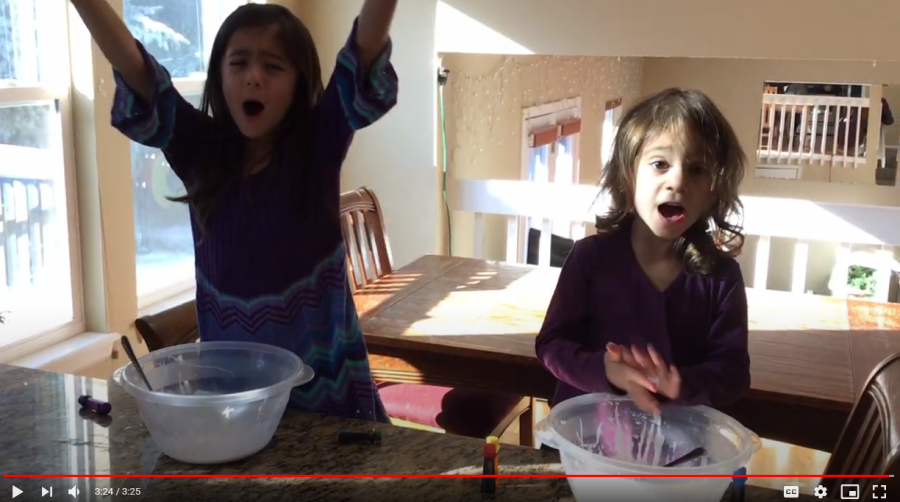What It’s Like to Teach During a Pandemic?
Science teacher Barbara Steward’s children help her make Chemistry lab videos more fun. This screenshot is from a lab where students made slime.
December 22, 2020
COVID-19 hit hard, whether it was the isolation or the virus itself, it wasn’t something we were ready for. However, life had to keep going, and teachers had to adapt to the changing landscape of teaching quickly.
“It was very difficult to prepare because we didn’t know exactly what it would look like,” science teacher Barbara Steward said. “I was also trying to get Link Leaders organized at that time. So I just had to go with it. Which was stressful for me back in August.”
A Hybrid Approach
Teachers were allowed to apply to teach remotely for the semester or teach on a hybrid schedule where cohorts took turns coming into the building and learning from home. Steward chose to teach on the hybrid schedule.
“Every week I had to reinvent what I taught last year,” Steward said. “I had to figure out what content was the most important to focus on and how to get students to engage with the content in some way that would be reasonable and not too much work for them. There was one week where I had absolutely no idea what direction to go in in Chemistry, and it was very stressful.”
Throughout the semester, teaching presented unique challenges as teachers had to balance work and home obligations, a balance that grew more difficult once the district moved all students to remote learning in November due to rising cases in the county. Steward and a few other teachers continued to work from school.
“Just like students, I also find it hard to focus, so I rarely work at home,” Steward said. “It’s also challenging at times to get my 1st grader to do her remote learning while I am also teaching remotely.”
Having to change from hybrid to remote teaching right before Thanksgiving break and continue through the end of the fall semester was one more challenge added to the list. Still, Steward persevered.
“An accomplishment has been to stay on top of my work,” Steward said. “For example, I don’t let grading pile up. At first, I hated teaching remotely, but now I think I’ve gotten a lot better at it, so I don’t mind it quite as much. That being said, I would still prefer to teach in person.”
Staying Remote
Before the school year began, social studies teacher Ryan Ogi applied to teach remotely for the fall semester. He was approved because his parents, whom he lives with, were at high risk for the virus.
“I was really scared mostly for my family especially because there wasn’t enough science to prove or disprove if high schoolers or kids could pass along the virus,” Ogi said. “So I thought I don’t know what I’m going to do if I can’t work. I’m very lucky the schools allowed me to work this way.”
Teaching remotely since the semester began, Ogi seemed to face similar challenges as teachers who were on the hybrid schedule.
“Keeping students interested in school and keeping them engaged, it’s been hard to do that,” Ogi said. “Mostly because there are so many distractions [at home].”
Not being in the building at all came with a unique set of challenges, primarily Ogi’s ability to develop relationships with his students.
“I do miss seeing all the students,” Ogi said. “It’s not the same as teaching in person. I feel less connected to the new students, but that’s only because I don’t know them or see them in the hallways.”
However, being able to work from home did provide Ogi with a few perks.
“I live really far from the school, so being able to wake up and get dressed and then go to work in less than 5 minutes—compared to having to wake up at 5 a.m. to just be on time—is a really nice change.”
Ogi primarily co-taught American Studies, the integrated class for 10th grade, with English teacher Jonathan White who also taught remotely. Both teachers altered their approach to the course this year to support students who were also learning remotely.
“I’ve been able to plan and create much stronger lessons,” Ogi said. “Mr. White and I have been able to spend a lot more time with the students that ask for help or just need it, and we’ve been able to make our lessons better.
Ogi and White changed the pacing of their class to allow students to accomplish specific tasks over the course of a week instead of posting daily lessons. The pair have noticed that this approach seems to be working with their remote students although it is not entirely perfect.
“For students who need more structure and who have a lot going on, having us do weekly lessons rather than daily lessons help them,” Ogi said. “But for others, because of all the time [spent] on assignments, they can get easily lost and forget that they even have school.”
Towards the spring semester
As of Dec. 18, the district updated its plan for returning to school after winter break. Officials hope that students in grades 6-12 will return to a hybrid schedule on Feb. 1.
While students continue to have the option to engage in 100% remote learning, more remote teachers were asked to return to the building to teach starting in January 2021. Ogi will continue to teach remotely for the spring semester.
